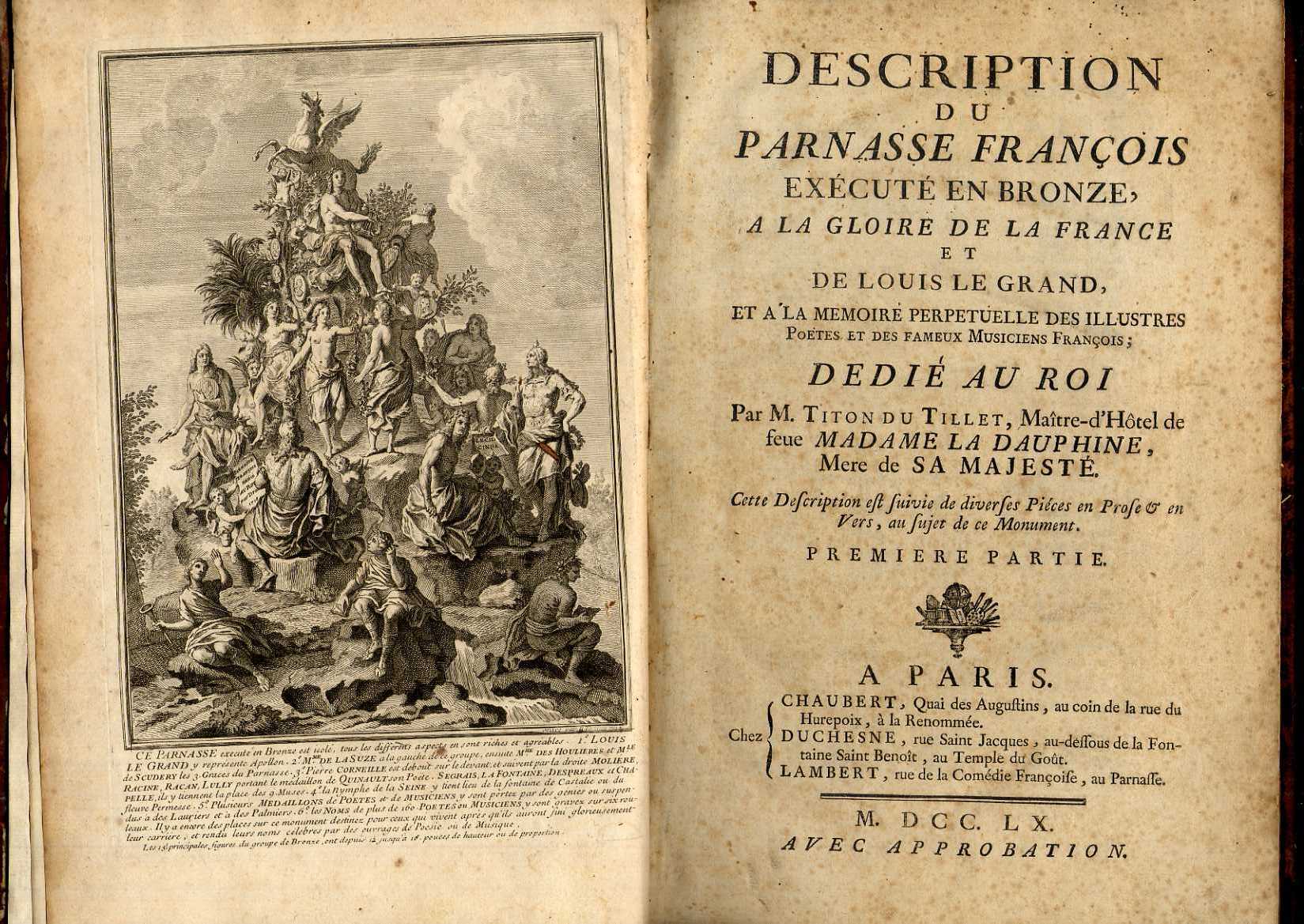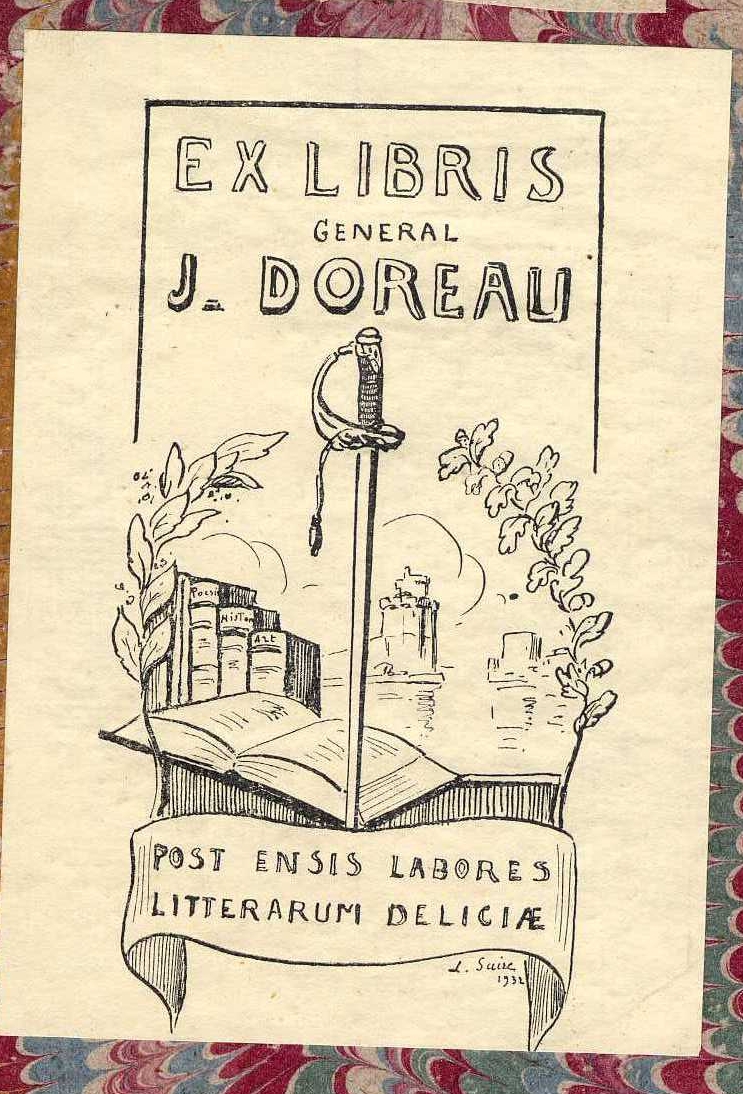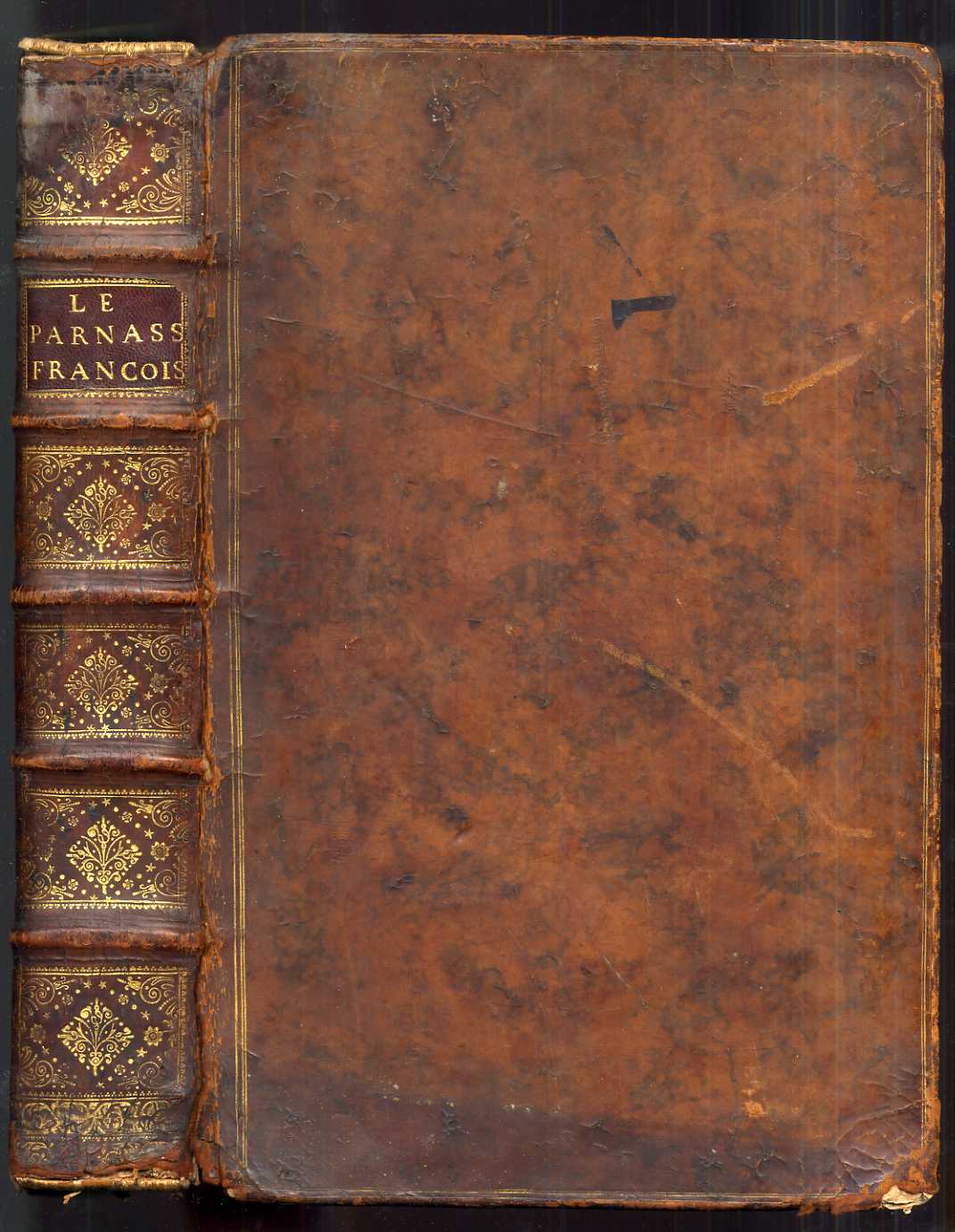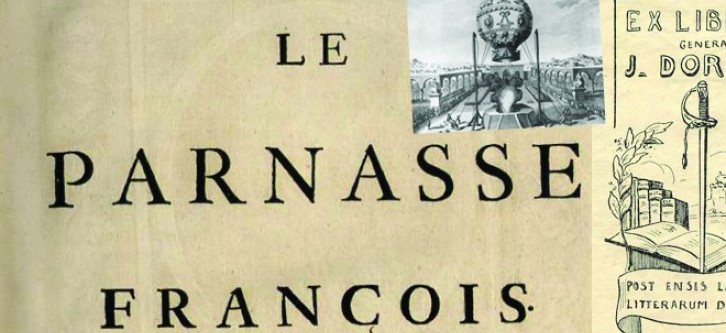At Pazzo Books, the shop that I kept for years in the outer neighborhoods of Boston, MA and now run out of a two-story in-law addition in my home, I've learned that old books are funny things. Often you catch them looking at you sideways, across a room, and it occurs to you to wonder what they've seen; where they've been; and what odd parade of owners they've survived. Typically you can only imagine, but once in a very long while a book wanders through with enough information stored in it, in bookplates, inscriptions, and ephemera, that you can piece together a narrative.
Évrard Titon du Tillet, great patron of the arts, son of Maximilien Titon de Villegenon, secretary to Louis XIV and alleged Scotsman, plotted to build a vast sculpture garden to celebrate the great writers, dramatists, artists, and musicians of France. Originally planned around a bronze statue, a model and description of which was executed in 1718, the project soon incorporated dozens of artists, growing to resemble a great folly (a penchant for which ran in the family; the Titon family mansion was called La Folie Titon). The budget swelled to 2 million livres and Tillet was forced to abandon the project.
Instead he turned his Parnassus into a book, Le Parnasse François, the first and largest installment of which appeared in 1732. Additions, often occasioned as artists died or gave up their craft, appeared in 1743, 1755 and 1760. This particular copy has the 1732 edition bound together with the 1743, and a second volume contains the 1760 additions. The 1755 is lacking. It's a tall book, in folio, bound in heavy calf — a consequential volume. It has seen better days; the front hinge is weakening a bit, as is frequently the case with heavy books, but remains attractive and reasonably sure of itself. The five raised bands on the spine are not, as is now common, for show, but to conceal the cords that hold the covers of the book together. The gilt lettering and design on the spine is rubbed and dulled, but remains bright enough to be charming.

The title page with an extravagant mock-up of the sculpture park.
The book is important for two reasons, and, as you might expect, neither of them has anything to do with the right worship of French genius. Titon de Tillet’s project is one of the first attempts at a public sculpture venerating genius. Now we take this sort of thing for granted, but at the time it was groundbreaking and, apparently, inaccrochable (as Gertrude Stein used to say — unpublishable, more or less). Most crucially though, Le Parnasse François records a great deal of history on second- and third-tier artists for which there is no other source of biographical information. In his attempt to celebrate the immortal, he retained a record of the more easily forgotten as well.
But this is all preliminaries, a mere back story to the story of this particular volume. It was written in 1732, though this copy, apparently, was not bound up until the 1743 supplement appeared. On the half-title page, across from the engraved portrait of Titon de Tillet, is written “corrigé par l’auteur” and the author’s manuscript corrections appear a dozen or so times in the margins, making minor corrections to the text.
Inside the front board is the armorial bookplate of Titon du Tillet’s great nephew, M. Titon de Villotran (1727–1794), a member of parliament and Counselor of the Grand Chamber. Certainly the volume must have been given to his father, the author’s nephew (explaining the authorial corrections which, while not uncommon at the time, were probably not affected on every copy), from whence T. de Villotran came into possession of it; or perhaps he was simply given the book for his 16th birthday. In either case, the volumes stayed in Paris and in the family.
Three years after Titon du Tillet's death in 1762, the family mansion was sold and turned into the Royal Wallpaper factory under the direction of Jean-Baptiste Réveillon. In one of the first outbreaks of violence, in April of 1789— three months before the storming of the Bastille — workers stormed the Wallpaper Factory and burned it to the ground. At the time, the former Folie Titon was reported to contain over 50,000 books. Perhaps these volumes were still there, perhaps they’d never been given to his nephew, never formed the backbone of an odd birthday present, or perhaps they ended up in Titon de Villotran’s possession after being rescued from the conflagration. M. Titon de Villotran was safely across town, though, a member of parliament, counselor of the Grand Chamber and a notoriously hard man. But his safety was short lived — as in so many other cases, his success in surviving La Révolution only led to an unkind end during La Terreur. In prairial, year 2 (September, 1794), Titon de Villotran met with the guillotine.
We’ll never know how the books escaped Villotran’s fate (speaking metaphorically, of course) but a note to the back of an endpaper “De la bibliothèque de L.M. Lepbib (?) Lieutenant Géneral de Nemours” suggests that they made their way to Nemours, just outside of Paris. Perhaps they crossed the Atlantic to America in 1799 when Nemours’s most famous son, Eleuthère Irénée du Pont de Nemours, made his way to Delaware. Pierre and E. I. DuPont were staunch royalists though, defending Louis and Marie in 1792 and being sentenced to the guillotine under Robespierre — a sentence that was still pending when Robespierre fell, though, after the DuPont mansion was sacked in 1797, they decided to stop taking their chances. I’d dearly love to report that Lieutenant General (”Bad Penmanship”) Lepbib met some unfortunate and unlikely end (as the author’s house was burned down by an angry mob and their first owner guillotined, a third might have brought us to genuinely cursed), but we will have to settle for the DuPont’s home. When we pick up its trail again, the book is in the library of “General J. Doreau.”

Bookplate of General J. Doreau.
General Doreau’s motto, “After the work of the sword, the delight of literature,” is pretty nice, but he’s a dead end. Nothing about him is easily accessible (except for his well-dispersed bookplates, which show up occasionally on expensive books). However, his brother was Bernard Doreau, and here’s where it gets interesting again: Bernard Doreau ran for office under the Parti Agraire, a right wing populist party formed in 1927. In a 1936 campaign poster tucked into the 1760 volume, he was either running against, or using as a straw man, one Eugene Frot. Frot had been Minister of the Interior during the “February 6 Crisis,” a populist and a proto-fascist (and also, variously, xenophobic, antisemitic, anti-freemason, anti-capitalist, and anti-democratic) uprising — the largest single participant of which was Action Française. It is frequently identified as the most fragile moment for the Third Republic, the French government which ruled from 1870–1940.
Perhaps some lonely historian at the Sorbonne on that cold day in 1934 reflected on how different this popular uprising was from the one which, some 147 years earlier, had led to the burning of the Royal Wallpaper Factory, the erstwhile Titonville, and the storming of the Bastille.
Already, Bernard Doreau had written a novel under the pen name “Max Dorian” entitled Le Sextant, ou Un Civil Chez les Marins. In fact, at the time of the hanging of this poster, he was probably in negotiations to publish his second novel (this time with Gallimard which would have been an exciting step up), Le Comte de Buenos-Aires (1937). It’s romantic to think that he fled France to disappear into his nom de plume, with only a baguette and a broken set of Le Parnasse François tucked under his arm.
Doreau/Dorian wrote only one more novel, Trinidad (1946), and then commenced a sort of second career as a cataloger of American enterprise. In succession he wrote: Du Pont de Nemours; de la Poudre au Nylon (and Du Pont de Nemours : de la Poudre au Nylon : Sélection Photographique with his photographer and wife Dixie Reynolds); Un bordelais fut le premier millionaire américan; Voilà Wall Street: ce qu’il faut savoir du marché financier américain; and, with a few scholarly books in between, DuPont de Nemours from the Histoire des grandes entreprises series.

Search for books about the Du Pont family...
Remember, the DuPont chemical company was founded as a gunpowder mill on the Brandywine Creek outside of Wilmington, Delaware, and profited off of every post-Revolutionary war in the United States's history. Maximilien Titon de Villegenon made a substantial part of his fortune and name from the introduction of small arms to the French military during his time as general manager of the armoires under Louis XIV (even our author, Évrard, great patron of the arts that he was, made a living for some time as "Police Chief of Wars"). In Dorian's note, above, he writes of "la science au service de la mort", an observation that could be applied to either or both of them.
Put end to end on a shelf, Dorian's later works form a sort of Parnassus of American business — an ode to the genius not of the arts, but capitalism. Starting with DuPont, manufacturers as they were of gunpowder, chemicals, the building blocks of a thousand, thousand products, Dorian distilled success to its purest, American, form. Wall Street, the millionaire, the folklore of the dollar. It's lovely in its way, this abstraction of success, raising of an edifice to the very essence of capitalist genius, like the French chef who ordered fifty hams for a feast, one for the meal and the other forty-nine to provide essence for his sauces. You can put this sort of sauce on anything.
Some few questions remain: Where is the missing middle volume? Was it lost to the Terror? To right wing marauders; to Germans; to Frot and his center-left beard? When did the books first make their way across the Atlantic? But I think I've woven enough concentricities. It made it to Boston, anyway, and that's not nothing. From Titon du Tillet, to Villotran; Nemours to Doreau to Pazzo Books — an impressive journey even absent the Royal Wallpaper fiasco, the French Revolution, The Terror, Napoleon, two World Wars, and a Skinner Auction.

-----
Note

More information about Titon du Tillet and his sculpture garrden can be found in Judith Colton's book, Parnasse Francois: Titon du Tillet and the Origins of the Monument to Genius







